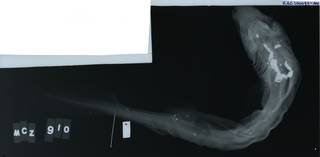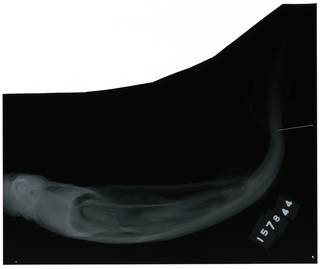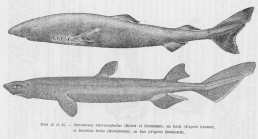
| Introduction | | Search taxa | | Taxon tree | | Taxon match | | Checklist | | Literature | | Stats | | Photogallery | | OBIS Vocab | | Log in |
WoRMS taxon detailsDalatias licha (Bonnaterre, 1788)
105910 (urn:lsid:marinespecies.org:taxname:105910)
accepted
Species
Dalatias lica (Bonnaterre, 1788) · unaccepted (misspelling)
Dalatias lichia (Bonnaterre, 1788) · unaccepted (misspelling)
Dalatias sparophagus Rafinesque, 1810 · unaccepted
Dalatias tachiensis Shen & Ting, 1972 · unaccepted
Pseudoscymnus boshuensis Herre, 1935 · unaccepted
Scymnorhinus brevipinnis Smith, 1936 · unaccepted
Scymnorhinus licha (Bonnaterre, 1788) · unaccepted (synonym)
Scymnorhinus phillippsi Whitley, 1931 · unaccepted
Scymnus aquitanensis de la Pylaie, 1835 · unaccepted
Scymnus vulgaris Cloquet, 1822 · unaccepted
Squalus americanus Gmelin, 1789 · unaccepted
Squalus licha Bonnaterre, 1788 · unaccepted (synonym)
Squalus nicaeensis Risso, 1810 · unaccepted
Squalus scymnus Voigt, 1832 · unaccepted
marine,
(of Squalus licha Bonnaterre, 1788) Bonnaterre, J. P. (1788). Tableau encyclopédique et méthodique des trois règnes de la nature... Ichthyologie. <em>Panckoucke, Paris.</em> i-lvi + 1-215, Pls. A-B. 1-100., available online at https://books.google.com/books?id=Z67NZ0_oObYC&pg=PR1 [details]
(of Scymnorhinus licha (Bonnaterre, 1788)) Bonaparte, C.L. (1846). Catalogo metodico dei pesci europei. <em>Atti della Settima Adunanza degli Scienziati Italiani Sesta Riunione, Milano 7a Adunanza, Napoli.</em> Part 2: 1-95. [details]
Description Found on the outer continental and insular shelves and slopes, most commonly below 200 m. Primarily a solitary shark. Feeds...
Description Found on the outer continental and insular shelves and slopes, most commonly below 200 m. Primarily a solitary shark. Feeds mainly on bony fishes and also skates, other sharks (Galeus, Squalus, Etmopterus and Centrophorus), and also on squids, octopi, amphipods, isopods, shrimps, lobsters, polychaetes and siphonophores. Adults eat more crustaceans and sharks and less cephalopods than young. Ovoviviparous with 10 to 16 young in a litter. Quite common. [details] Distribution from George's Bank, the east coast of Florida, Northern Gulf of Mexico, and off the southern Bahamas
Distribution from George's Bank, the east coast of Florida, Northern Gulf of Mexico, and off the southern Bahamas [details]
Froese, R. and D. Pauly. Editors. (2025). FishBase. Dalatias licha (Bonnaterre, 1788). Accessed through: World Register of Marine Species at: https://www.marinespecies.org/aphia.php?p=taxdetails&id=105910 on 2025-07-15
Date action by
Nomenclatureoriginal description
(of Squalus licha Bonnaterre, 1788) Bonnaterre, J. P. (1788). Tableau encyclopédique et méthodique des trois règnes de la nature... Ichthyologie. <em>Panckoucke, Paris.</em> i-lvi + 1-215, Pls. A-B. 1-100., available online at https://books.google.com/books?id=Z67NZ0_oObYC&pg=PR1 [details] original description (of Scymnorhinus licha (Bonnaterre, 1788)) Bonaparte, C.L. (1846). Catalogo metodico dei pesci europei. <em>Atti della Settima Adunanza degli Scienziati Italiani Sesta Riunione, Milano 7a Adunanza, Napoli.</em> Part 2: 1-95. [details] original description (of Scymnorhinus phillippsi Whitley, 1931) Whitley, G. P. (1931). New names for Australian fishes. <em>Australian Zoologist.</em> v. 6 (pt 4): 310-334, Pls. 25-27. [details] original description (of Dalatias sparophagus Rafinesque, 1810) Rafinesque, C. S. (1810). Caratteri di alcuni nuovi generi e nuove specie di animali e piante della sicilia, con varie osservazioni sopra i medisimi. <em>Per le stampe di Sanfilippo: Palermo, Italy.</em> Part 1 involves fishes, pp. [i-iv] 3-69 [70 blank], Part 2 with slightly different title, pp. ia-iva + 71-105 [106 blank]). Pls. 1-20., available online at https://www.biodiversitylibrary.org/page/47825964 [details] basis of record van der Land, J.; Costello, M.J.; Zavodnik, D.; Santos, R.S.; Porteiro, F.M.; Bailly, N.; Eschmeyer, W.N.; Froese, R. (2001). Pisces, <B><I>in</I></B>: Costello, M.J. <i>et al.</i> (Ed.) (2001). <i>European register of marine species: a check-list of the marine species in Europe and a bibliography of guides to their identification. Collection Patrimoines Naturels,</i> 50: pp. 357-374 (look up in IMIS) [details] Ecologyecology source
Looby, A.; Erbe, C.; Bravo, S.; Cox, K.; Davies, H. L.; Di Iorio, L.; Jézéquel, Y.; Juanes, F.; Martin, C. W.; Mooney, T. A.; Radford, C.; Reynolds, L. K.; Rice, A. N.; Riera, A.; Rountree, R.; Spriel, B.; Stanley, J.; Vela, S.; Parsons, M. J. G. (2023). Global inventory of species categorized by known underwater sonifery. <em>Scientific Data.</em> 10(1). (look up in IMIS), available online at https://doi.org/10.1038/s41597-023-02745-4 [details] Othercontext source (Deepsea)
Intergovernmental Oceanographic Commission (IOC) of UNESCO. The Ocean Biogeographic Information System (OBIS), available online at http://www.iobis.org/ [details]
context source (Bermuda) Clark, E.; Kristof, E. (1990). Deep-sea elasmobranchs observed from submersibles off Bermuda, Grand Cayman, and Freeport, Bahamas In: Pratt, Jr., H. L., S. H. Gruber & T. Taniuchi (eds.), Elasmobranchs as Living Resources: Advances in the Biology, Ecology, Systematics, and the Status of the Fisheries. NOAA Technical Report 90, 269-284 [details] additional source Collette, B. B., ; Klein-MacPhee, G. (2002). Bigelow and Schroeder's Fishes of the Gulf of Maine. <em>Smithsonian Institution Press.</em> 1-748. [details] additional source Muller, Y. (2004). Faune et flore du littoral du Nord, du Pas-de-Calais et de la Belgique: inventaire. [Coastal fauna and flora of the Nord, Pas-de-Calais and Belgium: inventory]. <em>Commission Régionale de Biologie Région Nord Pas-de-Calais: France.</em> 307 pp., available online at http://www.vliz.be/imisdocs/publications/145561.pdf [details] additional source King, C.M.; Roberts, C.D.; Bell, B.D.; Fordyce, R.E.; Nicoll, R.S.; Worthy, T.H.; Paulin, C.D.; Hitchmough, R.A.; Keyes, I.W.; Baker, A.N.; Stewart, A.L.; Hiller, N.; McDowall, R.M.; Holdaway, R.N.; McPhee, R.P.; Schwarzhans, W.W.; Tennyson, A.J.D.; Rust, S.; Macadie, I. (2009). Phylum Chordata: lancelets, fishes, amphibians, reptiles, birds, mammals. <em>in: Gordon, D.P. (Ed.) (2009). New Zealand inventory of biodiversity: 1. Kingdom Animalia: Radiata, Lophotrochozoa, Deuterostomia.</em> pp. 431-554. [details] additional source McEachran, J. D. (2009). Fishes (Vertebrata: Pisces) of the Gulf of Mexico, Pp. 1223–1316 in: Felder, D.L. and D.K. Camp (eds.), Gulf of Mexico–Origins, Waters, and Biota. Biodiversity. Texas A&M Press, College Station, Texas. [details] additional source Liu, J.Y. [Ruiyu] (ed.). (2008). Checklist of marine biota of China seas. <em>China Science Press.</em> 1267 pp. (look up in IMIS) [details] Available for editors additional source Nijssen, H.; de Groot, S.J. (1987). De vissen van Nederland: systematische indeling, historisch overzicht, het ontstaan van de viskweek, uitheemse vissoorten, determineersleutels, beschrijvingen, afbeeldingen, literatuur, van alle in Nederlandse wateren voor komende zee- en zoetwatervissoorten [Fishes of the Netherlands: systematic classification, historical overview, origins of fish culture, non-indigenous species, determination keys, descriptions, drawings, literature references on all marine and freshwater fish species living in Dutch waters]. KNNV Uitgeverij: Utrecht, The Netherlands. ISBN 90-5011-006-1. 224 pp. (look up in IMIS) page(s): 12 [details] additional source Bonnaterre, J. P. (1788). Tableau encyclopédique et méthodique des trois règnes de la nature... Ichthyologie. <em>Panckoucke, Paris.</em> i-lvi + 1-215, Pls. A-B. 1-100., available online at https://books.google.com/books?id=Z67NZ0_oObYC&pg=PR1 page(s): 12 [details] additional source Froese, R. & D. Pauly (Editors). (2025). FishBase. World Wide Web electronic publication. version (06/2024)., available online at https://www.fishbase.org [details]  Present Present  Present in aphia/obis/gbif/idigbio Present in aphia/obis/gbif/idigbio  Inaccurate Inaccurate  Introduced: alien Introduced: alien  Containing type locality Containing type locality
Unreviewed
Description Found on the outer continental and insular shelves and slopes, most commonly below 200 m. Primarily a solitary shark. Feeds mainly on bony fishes and also skates, other sharks (Galeus, Squalus, Etmopterus and Centrophorus), and also on squids, octopi, amphipods, isopods, shrimps, lobsters, polychaetes and siphonophores. Adults eat more crustaceans and sharks and less cephalopods than young. Ovoviviparous with 10 to 16 young in a litter. Quite common. [details]Distribution from George's Bank, the east coast of Florida, Northern Gulf of Mexico, and off the southern Bahamas [details] Habitat benthic [details] Habitat Known from seamounts and knolls [details]
Marine Life Information Network - UK
To Barcode of Life (53 barcodes) To Biodiversity Heritage Library (1 publication) (from synonym Scymnorhinus phillippsi Whitley, 1931) To Biodiversity Heritage Library (1 publication) (from synonym Scymnus aquitanensis de la Pylaie, 1835) To Biodiversity Heritage Library (10 publications) (from synonym Squalus nicaeensis Risso, 1810) To Biodiversity Heritage Library (11 publications) (from synonym Dalatias lichia (Bonnaterre, 1788)) To Biodiversity Heritage Library (12 publications) (from synonym Squalus licha Bonnaterre, 1788) To Biodiversity Heritage Library (13 publications) (from synonym Scymnorhinus licha (Bonnaterre, 1788)) To Biodiversity Heritage Library (17 publications) (from synonym Dalatias sparophagus Rafinesque, 1810) To Biodiversity Heritage Library (2 publications) (from synonym Pseudoscymnus boshuensis Herre, 1935) To Biodiversity Heritage Library (26 publications) To Biodiversity Heritage Library (3 publications) (from synonym Scymnus vulgaris Cloquet, 1822) To Biodiversity Heritage Library (3 publications) (from synonym Squalus scymnus Voigt, 1832) To Biodiversity Heritage Library (69 publications) (from synonym Squalus americanus Gmelin, 1789) To Biological Information System for Marine Life (BISMaL) To Biological Information System for Marine Life (BISMaL) (from synonym Scymnorhinus licha (Bonnaterre, 1788)) To European Nucleotide Archive, ENA (Dalatias licha) To FishBase (from synonym Squalus licha Bonnaterre, 1788) To FishBase (from synonym Dalatias sparophagus Rafinesque, 1810) To FishBase To FishBase (from synonym Squalus nicaeensis Risso, 1810) To FishBase (from synonym Dalatias tachiensis Shen & Ting, 1972) To FishBase (from synonym Squalus americanus Gmelin, 1789) To FishBase (from synonym Scymnorhinus brevipinnis Smith, 1936) To FishBase (from synonym Scymnorhinus phillippsi Whitley, 1931) To FishBase (from synonym Squalus scymnus Voigt, 1832) To FishBase (from synonym Dalatias lica (Bonnaterre, 1788)) To FishBase (from synonym Dalatias lichia (Bonnaterre, 1788)) To FishBase (from synonym Scymnus vulgaris Cloquet, 1822) To FishBase (from synonym Scymnus aquitanensis de la Pylaie, 1835) To FishBase (from synonym Pseudoscymnus boshuensis Herre, 1935) To FishBase (from synonym Scymnorhinus licha (Bonnaterre, 1788)) To FishBase images (Dalatias licha, Azores Is., by Cambraia Duarte, P.M.N. (c)ImagDOP) To GenBank (56 nucleotides; 48 proteins) To GenBank (56 nucleotides; 48 proteins) (from synonym Squalus licha Bonnaterre, 1788) To Global Biotic Interactions (GloBI) To IUCN Red List (Vulnerable) To NMNH Extant Collection (Dalatias licha RAD100094-001) To NMNH Extant Collection (Dalatias licha RAD100095-001) To PESI To ITIS |




